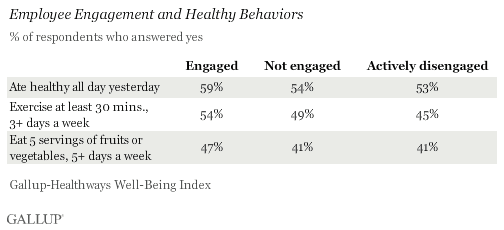WASHINGTON, D.C. -- American workers who are engaged in their work and workplace are more likely to report a healthier lifestyle than their counterparts who are not engaged or who are actively disengaged. Engaged employees eat healthier, exercise more frequently, and consume more fruits and vegetables.

These findings are from Gallup Daily tracking interviews conducted January through December 2012. Gallup's employee engagement index is based on extensive research on actionable workplace elements with proven linkages to performance outcomes, including productivity, customer service, quality, retention, safety, and profit. The 12 questions included in the survey are intended to help sort workers into one of three categories: engaged, not engaged, or actively disengaged.
Engaged employees are deeply involved in and enthusiastic about their work. Those who are not engaged may be satisfied, but are not emotionally connected to their workplaces and are less likely to put in discretionary effort. Employees who are actively disengaged are emotionally disconnected from their work and workplace and jeopardize their teams' performance.
Gallup research previously found that employee engagement is positively correlated with better health -- engaged workers are less likely to be obese and to have chronic diseases. The positive correlation between employee engagement and healthy behaviors holds true after controlling for respondents' health conditions and key demographics, such as age, gender, race, income, education, and marital status.
Implications
Gallup research shows that how leaders manage their workers can significantly influence their employees' engagement, which in turn affects a company's bottom line and workers' health and well-being. Separate Gallup research found that engaged employees were 21% more likely than actively disengaged employees to be involved in wellness programs offered by their company. This finding is consistent across age, BMI groups (normal, overweight, and obese), and among people with or without chronic diseases.
Taken together, the data showcase the link between being engaged at work and leading a healthy lifestyle. It is not clear though which way the relationship between engagement in the workplace and healthy behaviors goes. It is possible that workers without healthy lifestyles are more prone to illness, which then reduces their chance for being engaged at work, or that those who are actively disengaged are less likely to take part in healthy behaviors, perhaps due to time or a depressed outlook on life.
Regardless, since engaged employees are more likely to lead a healthy lifestyle, workplaces that actively improve engagement may end up seeing an added benefit of better employee health -- the potential benefits of which include reducing healthcare costs for a company in the long term and increasing energy and productivity in the near future.
About the Gallup-Healthways Well-Being Index
The Gallup-Healthways Well-Being Index tracks well-being in the U.S. and provides best-in-class solutions for a healthier world. To learn more, please visit well-beingindex.com.
Survey Methods
Results are based on telephone interviews conducted as part of the Gallup Daily tracking survey January to December 2012, with a random sample of 353,563 adults, aged 18 and older, living in all 50 U.S. states and the District of Columbia, selected using random-digit-dial sampling. The survey includes 19,392 unemployed; 14,881 actively disengaged; 43,136 not engaged; and 24,611 engaged respondents.
Maximum expected error ranges for subgroups vary according to size, ranging from ±2.8 percentage points for the largest group to ±4.9 percentage points for the smallest group.
Interviews are conducted with respondents on landline telephones and cellular phones, with interviews conducted in Spanish for respondents who are primarily Spanish-speaking. Each daily sample includes a minimum quota of 200 cellphone respondents and 800 landline respondents, with additional minimum quotas among landline respondents for gender within region. Landline respondents are chosen at random within each household on the basis of which member had the most recent birthday.
Samples are weighted by gender, age, race, Hispanic ethnicity, education, region, adults in the household, cellphone-only status, cellphone-mostly status, and phone lines. Demographic weighting targets are based on the March 2011 Current Population Survey figures for the aged 18 and older non-institutionalized population living in U.S. telephone households. All reported margins of sampling error include the computed design effects for weighting and sample design.
In addition to sampling error, question wording and practical difficulties in conducting surveys can introduce error or bias into the findings of public opinion polls.
For more details on Gallup's polling methodology, visit https://www.gallup.com/.
